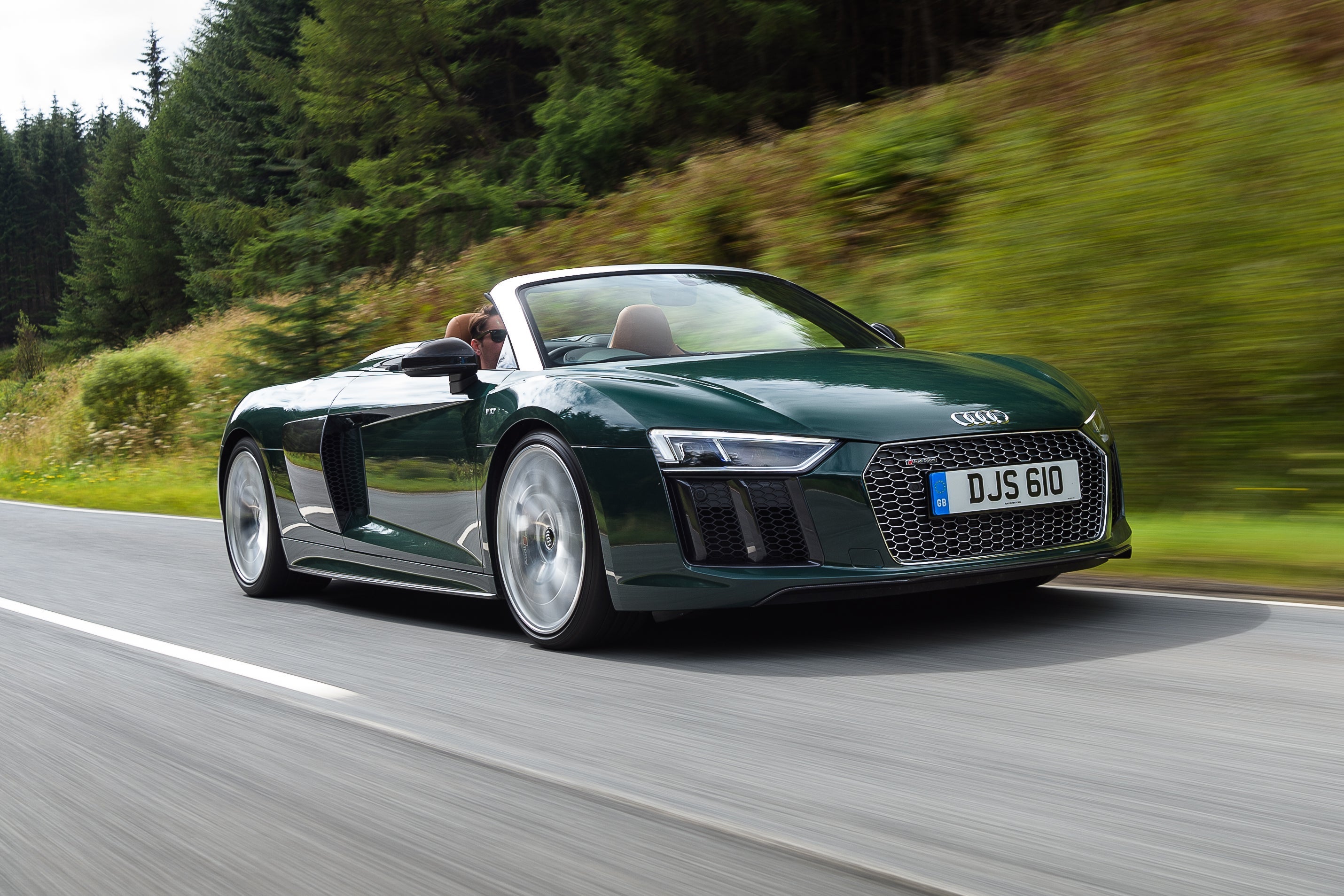Audi R8 Spyder (2017-2024) Review
Written by Dan Powell
Quick overview
Pros
- Thunderously fast
- Powered by Audi’s legendary V10 engine
- Refined and comfortable cabin
Cons
- Disappointing fuel economy
- Limited storage space
- Not as rewarding to drive as the Porsche 911
Overall verdict
"The R8 Spyder convertible is extremely fast, extremely capable and, thanks to the folding fabric roof, it’s even easier to appreciate the glorious, howling, crackling V10 engine. In short, it's sublime."
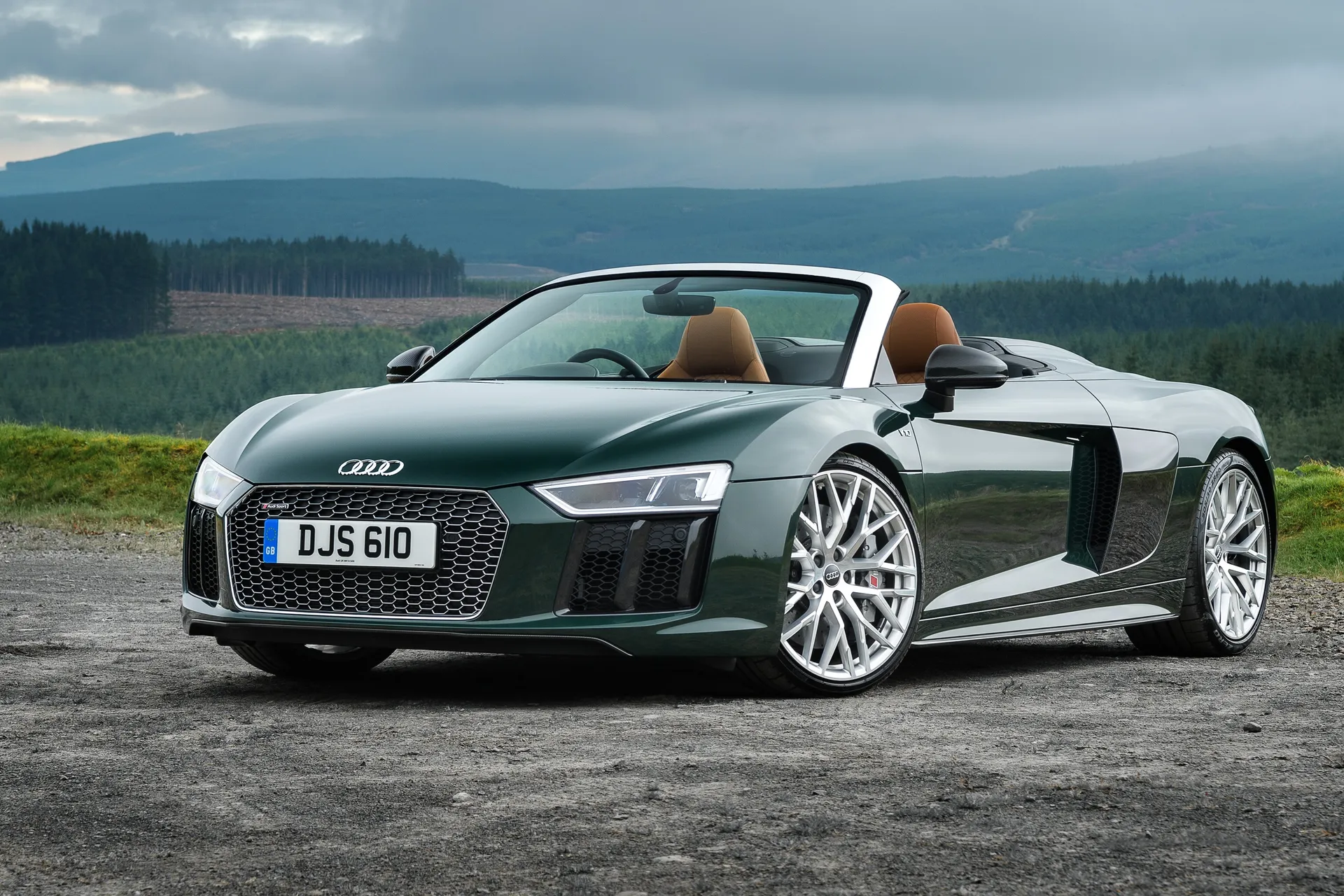
If there is one thing about the R8 Spyder that stands out, it’s the noise. It sounds fantastic, with a soaring howl as the revs climb and - in any one of the sportier settings - thumping, thunderous cracks on the overrun, which sound all the better with the roof down.
Power’s sent to all four wheels via a seven-speed automatic transmission, which can be overridden by the driver using paddles on the steering wheel. That means there’s plenty of control over the engine when needed, such as when tackling a series of bends. But if you're stuck in a stop-start traffic jam or cruising for a few hundred miles on the motorway, the R8 is really easy to drive.
Folding the top takes 20 seconds at speeds up to just over 30mph, so it’s possible to raise or lower it on the move around town if you get caught in a sudden downpour. The choice of fabric, as opposed to a metal multi-piece metal roof, means weight is kept down, while engineers have worked hard to maintain body rigidity with various components using thicker metal than in the coupe version.
The R8 Spyder isn’t as good to drive as its rivals. This is mostly down to weight, with the R8 tipping the scales at two tonnes. That’s a lot for a high performance car - and a whopping 500kg more than the 570S Spyder.
That said, the R8’s more useful than the McLaren. The steering is better weighted at urban speeds and the throttle and brake controls are more refined. This means the R8 Spyder will suit drivers who want a 200mph supercar they can use everyday.
The R8 Spyder does have lots of character and its naturally aspirated ten-cylinder V10 is the star of the show. It is a high-revving monster of an engine that delivers rapid performance, all the way to 8700rpm. In our opinion, it’s one of the best supercar engines ever made.
The four-wheel drive system also ensures the R8 is a predictable and forgiving car, with the electronic system automatically diverting power to the front axle when it detects loss of traction.
It might not match its rivals on track performance, but the R8 is still one of the keys of the supercar pack. If you are new to the world of supercars, this is the best place to start.
If you're looking for the hard top version, you need our Audi R8 (2015-) review.
Is the Audi R8 Spyder right for you?
If you’re after a drop-top performance car, the R8 Spyder should be very near the top of your list.
Comfortable, luxurious and brutally fast, the R8 Spyder blends supercar performance with everyday useability. Standard equipment is high with LED headlights, leather seats, automatic air conditioning and navigation fitted as standard. In our view, the R8 Spyder has the best cabin of any soft-top on sale.
The R8 is not a quiet car. Even with the fabric roof in place, the V10’s ever present. Some drivers will find the noise to be too much to bear over the long term. Fuel costs are also high, with mpg averaging in the low-20s.
The R8 Spyder isn’t as sharp as some of its key rivals to drive, due to the fact it’s much heavier. The Porsche 911, for example, is better to drive and more engaging at high speed. But only supercar veterans will notice the R8’s shortcomings.
What's the best R8 Spyder model/engine to choose?
The V10 Plus/Performance models provide the ultimate R8 Spyder experience. These get the most powerful version of the 5.2-litre V10 engine and higher levels of standard equipment, which include a reversing camera and higher quality leather sport seats with height adjustment.
Given the choice we’d recommend the R8 Spyder built from 2020 onwards. These models benefit from the mid-life update, with higher levels of standard equipment and important tweaks to the suspension and steering that make the R8 more involving to drive.
It’s very hard to find fault with the ‘standard’ Audi R8 Spyder. It’s more dramatic than the coupe from the driver's seat, thanks to the rush of wind and screaming engine, plus it has real supercar presence. No matter what version you chose, you’re unlikely to be disappointed.
What other cars are similar to the Audi R8 Spyder?
The key rivals here are the Porsche 911 and the McLaren 570S. Neither can match the R8 Spyder for refinement or comfort, but both have the edge when it comes to handling.
The 2020 update made the R8 Spyder sharper to drive, with revisions to the suspension and steering, but even with these improvements, the R8 Spyder lags behind its rivals. This is due to the fact it weighs a substantial 2050kg - 500kg more than the 570S.
The R8 Spyder is the better daily driver, however, with its smooth steering and refined engine and brakes making it easier to use in and around town. Audi’s comprehensive parking assistance package (fitted as standard) also takes the stress out of parking.
The interior of the R8 is a real step up in quality, compared to its rivals. The fit and finish is excellent and on a par with anything else in the Audi range. The infotainment system is easy to use too, thanks to the digital instrument binnacle.
Comfort and design
"The R8 Spyder provides good levels of comfort: the interior is spacious, with lots of head and legroom, while the seats are supportive and pretty good for a long journey. "
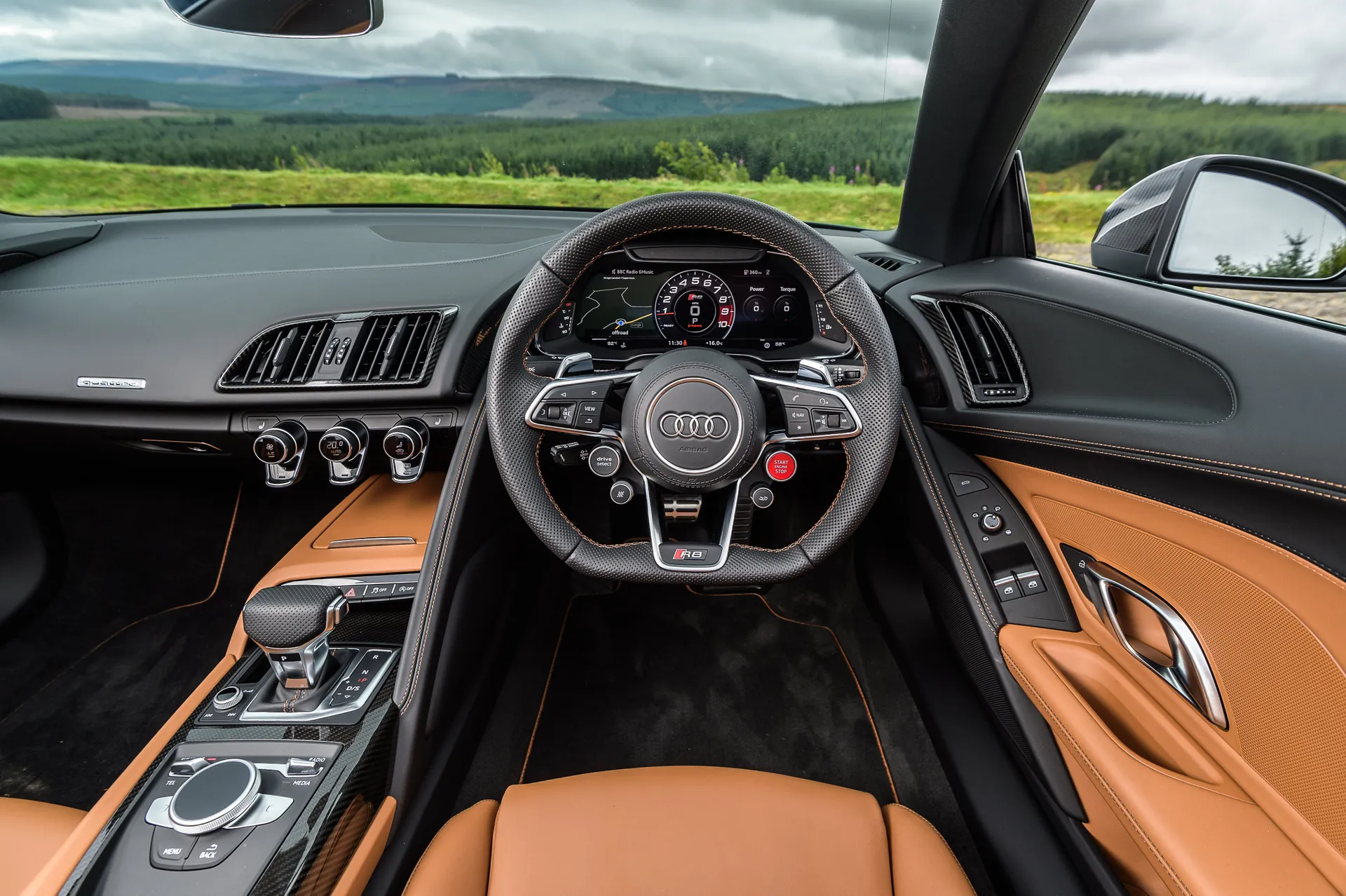
Given the choice, we’d choose the V10 Plus/Performance model to get the higher quality bucket sports seats, which feature electric height adjustment and improved padding support.
The driving position is excellent, thanks to the steering wheel having lots of adjustment, but the thick front pillars have a habit of hindering visibility, especially on roundabouts where small cars and cyclists can be momentarily obscured.
The doors are long too, and require a wide area to sweep open. This means it can be very difficult to get in and out of the R8 when space is limited, like a multistorey car park. There are a pair of cupholders in the centre storage box, but the door pockets are very small and will not hold anything of use.
Quality and finish
This is no stripped-out, back-to-basics machine – there’s leather upholstery, solid build quality and typical Audi attention to detail, from little things like the perfectly damped close on storage bin lids to buttons and dials that feel just right when operated.
In our opinion, the R8 Spyder is a class leader in the supercar segment when it comes to luxury and quality. The cabin is covered with lots of high quality soft-touch leathers and plastics, while the steering wheel is finished in a soft-touch microfiber suede material that’s identical to that of the R8 LMS GT3 race car.
Infotainment
Audi’s ‘virtual cockpit’ system is fitted as standard to most versions of the R8 Spyder. This replaces the traditional instrument binnacle with a sharp 12-inch screen.
Everything from speed and temperature to navigation, music and mobile phone connectivity is in the instrument binnacle behind the steering wheel. It’s crystal clear and all controlled from a rotary dial on the centre console, or via steering wheel buttons. It works beautifully, enabling the driver to keep eyes ahead all of the time and to emphasise the info they want to see most of all. The R8 Spyder’s infotainment system also has full compatibility with Apple CarPlay and Android Auto.
Unlike its rivals, the R8 doesn’t get a screen in the centre of the dashboard. But there are some nice touches, with the ventilation temperature being displayed on the centre of the control dials.
Navigation is fitted as standard to all versions of the R8 Spyder. This system is identical to the sat nav found in other upmarket Audi models and features live traffic updates and automatic rerouting to avoid congestion on closed roads.
Space and practicality
In terms of practicality, the R8 Spyder isn’t great. The mid-mounted engine means there is no rear boot, but there’s a 112-litre storage area under the bonnet which is large enough for a couple of soft bags or a small trip to the shops.
Inside there are some little cubby holes, but space is very limited. That said, weekends away won’t be out of the question as long as you pack light.
Unlike the coupe, you don’t get a storage shelf behind the seats in the cabin. This means the R8 Spyder will not suit those who want to travel with any meaningful level of luggage.
Handling and ride quality
"The R8 Spyder is a hugely rewarding car to drive. The high-revving V10 delivers its power with a smooth but rapid flow that makes it easy to use. The steering is firm and nicely weighted, which means you get a good feel for the road conditions."
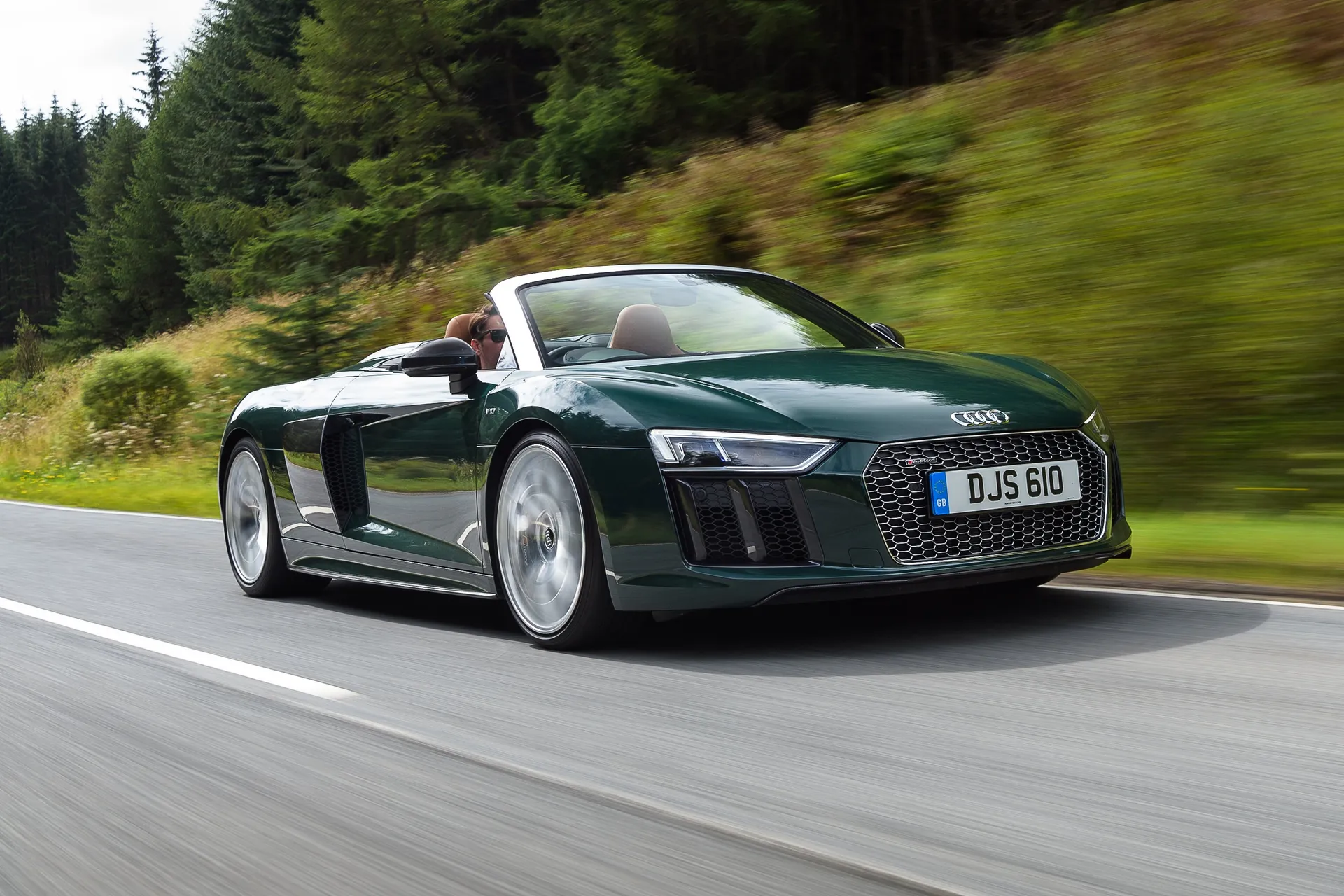
If you’re a supercar veteran then you might detect a bit of flex in the chassis when pressing the Spyder hard- something that can upset the handling of soft-top cars - but to most drivers the R8 is more than stiff enough, neatly tackling bends without any obvious body roll.
Some drivers might find the steering to be a little too soft. Even with the optional dynamic steering pack, the R8 doesn’t feel as crisp as a Porsche 911 or McLaren 570S. This was addressed in 2020 as part of the R8’s mid-life update, with revisions to the suspension and steering.
The R8 Spyder is surprisingly comfortable for a performance car, the R8’s firm over speed bumps and potholes, but it’s never harsh, whether equipped with the optional magnetic ride system or standard suspension.
The R8 may be a fire breathing supercar but it’s generally good to drive at low-speeds. The light steering makes it easy to guide the R8 into a parking space, while the standard fit parking sensors protect you against any mistakes from unseen bits of road furniture.
The V10’s refinement also comes into its own at sub-30mph speeds, with just a light touch of the throttle or brakes needed to adjust the speed when trundling along in heavy traffic.
Engines and gearboxes
The R8 Spyder is one of the few supercars that hasn’t shifted to turbocharged engines. How long this will continue for, we don’t know, but Audi’s ten-cylinder 5.2-litre will go down as one of the best V10 engines of all time.
The powertrain shares half of its components with the R8 LMS GT3 race car. This is evident from the moment you fire up the V10, with it erupting into a chorus of crackles and pops that wouldn’t be out of place on the Le Mans starting grid. In short, it’s fantastic.
At launch, the V10 was offered with 540PS and 610PS. In its fastest form, the V10 will carry you to 62mph in 3.3 seconds and then onwards to a top speed of 203mph.
In 2020, the V10 received a power upgrade as part of its mid-life update. The entry-model was uprated by 30PS ( to 570PS) while the V10 Plus model was rebranded ‘V10 Performance’ and given an extra 10PS, taking its total output to 620PS.
The R8 Spyder is fitted with a seven-speed dual clutch S tronic automatic gearbox (there’s no manual option), but the driver can operate the gears via paddles mounted behind the steering wheel.
Most cars for sale get Audi’s quattro four-wheel drive system as standard. A rear-wheel drive version was added as a limited edition model in 2018, before being made a permanent model in 2020. The R8 RWD uses the same engine and gearbox as the coupe, but uses a limited slip differential on the rear axle to maximise rear-wheel drive traction.
Refinement and noise levels
If you want a car that’s quiet then a V10 supercar will probably not be for you. The R8 starts up with a chorus of crackles and pops, before settling into a deep burble that builds to a thunderous teeth rattling roar as you travel up the rev range.
The cloth roof does filter out the harshest road and engine noise, but the R8 Spyder is not a quiet place to spend a journey. Indeed, some passengers might find the V10’s assault on the senses to be quite tiring after a while.
The electronic cloth roof takes 20 seconds to be lowered/raised and this can be done while the car is on the move, up to speeds of 31mph.
With all of the windows closed and the optional wind deflector installed, the cabin isn’t as blustery as you might expect from a huge open-top supercar. Most of the air flows straight over the top and only sidewinds from large vehicles, like HGVs, will cause the odd gust of air to whip up inside the cabin.
The V10 engine and seven-speed dual clutch S tronic automatic gearbox is extremely refined. Power delivery is rapid but smooth. The V10 will rev all the way to the red line, at 8700rpm. This means it’s high-revving and responsive.
The gear changes are predictable and intelligent. This means you can drive quickly without the car being destabilized by a random mid-corner downshift. The ‘box will also keep things relaxing and sedate at urban speeds, which means you can travel around town without any unpleasant jolts from the transmission.
Safety equipment
The R8 Spyder is built from a lightweight aluminium chassis that’s strengthened by carbon fibre to maximise strength.
The R8 has never been submitted for Euro NCAP testings and this means it officially has no star rating. Strangely, there is no active safety tech either. This means the R8 doesn’t provide automatic emergency city braking or adaptive cruise control.
Due to its soft-top, the R8 Spyder has two steel sections pretensioned by springs in the convertible top module, which serve as roll-over protection. Airbags are also supplied for both the driver and passenger.
MPG fuel costs
"The R8 Spyder is powered by a V10 engine with an unquenchable thirst for fuel. Officially, the entry-level cars will return 24.1mpg, while the V10 Plus/Performance are advertised with 22.6mpg. In reality, you’ll be lucky to surpass 20mpg. "
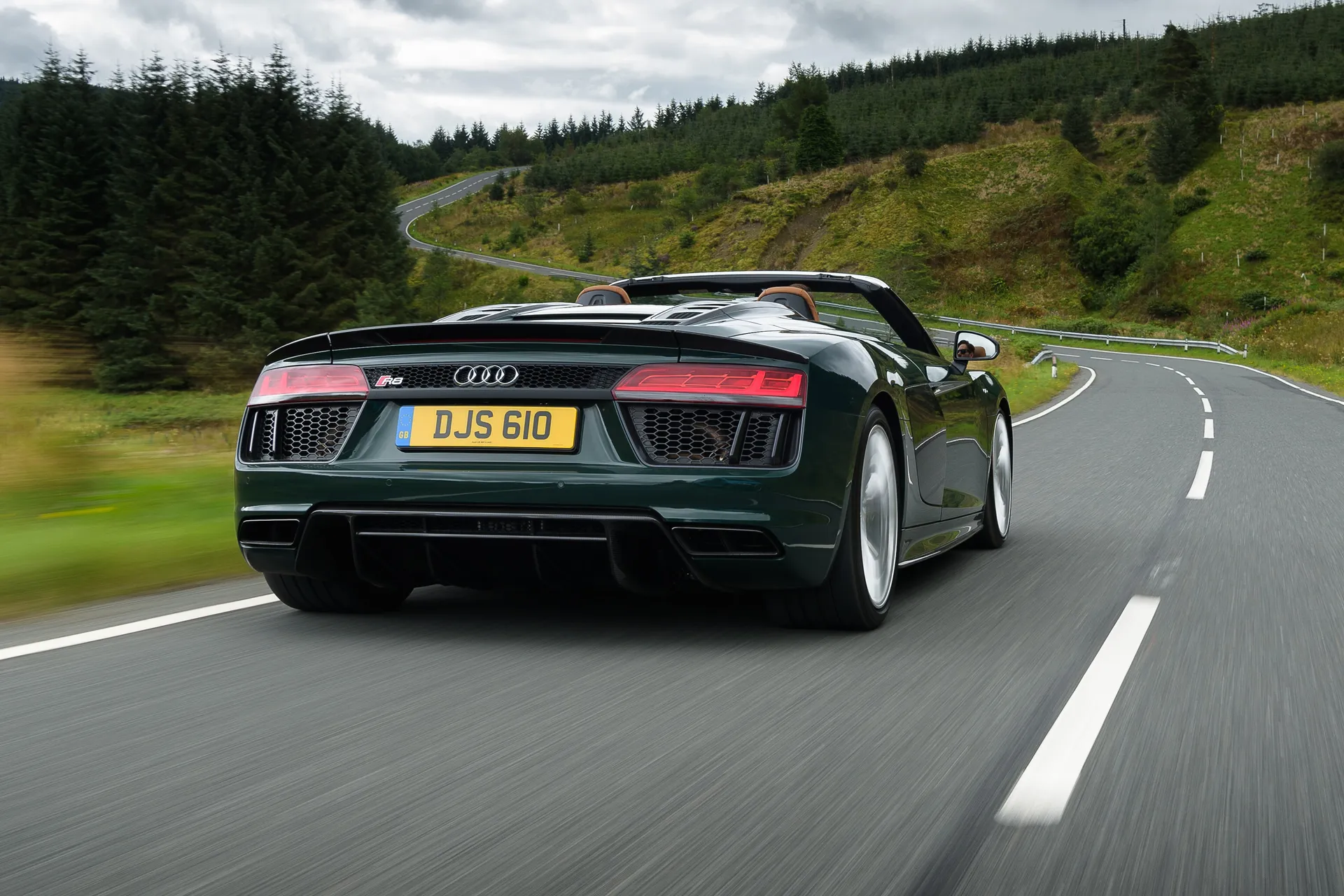
The V10 will average as low as 13mpg in stop start city traffic, while track driving will push it down even further. Pressed hard, the R8 Spyder will easily get into single mpg figures. So be prepared to become familiar with your local fuel station attendant, because you are going to be seeing a lot of each other.
Insurance groups and costs
Supercars attract super sized insurance premiums, due to their value and desirability. This means you’ll be looking at the highest insurance group 50.
As with any high performance (and high value) vehicle, it pays to find a specialist insurance company or broker to get the best cover. Insurers may provide discounts for an R8 Spyder that’s fitted with a tracker, that will make the car easier to trace in the event of a theft.
If you’re fortunate enough to get the R8 Spyder as a company car, you’ll be looking at a BIK rate of 37%.
VED
The V10 that powers the R8 may be one of the best in the supercar business, but it won’t win any eco awards. The ten-cylinder naturally aspirated 5.2-litre unit pumps out 300g/km of CO2, which puts it among the most polluting modern cars on the road.
The most expensive R8 Spyder models for road tax are registered between 2015 and 2017 - the VED for these are weighted against the old CO2 based system. This means 12 month’s VED will set you back around £600.
Road tax costs are cheaper for cars registered after 1 April 2017. The R8 qualifies for the flat £150 rate, plus the additional premium car rate of £325. This means you’ll be looking at £475 per year, but this will drop to £150 when the car reaches the sixth anniversary of its first registration.
How much should you be paying?
"List prices for the Audi R8 Spyder start at £122,000 for the rear-wheel drive model and £136,000 for the all-wheel drive quattro. The V10 Performance version is the most expensive, at £149,000. "
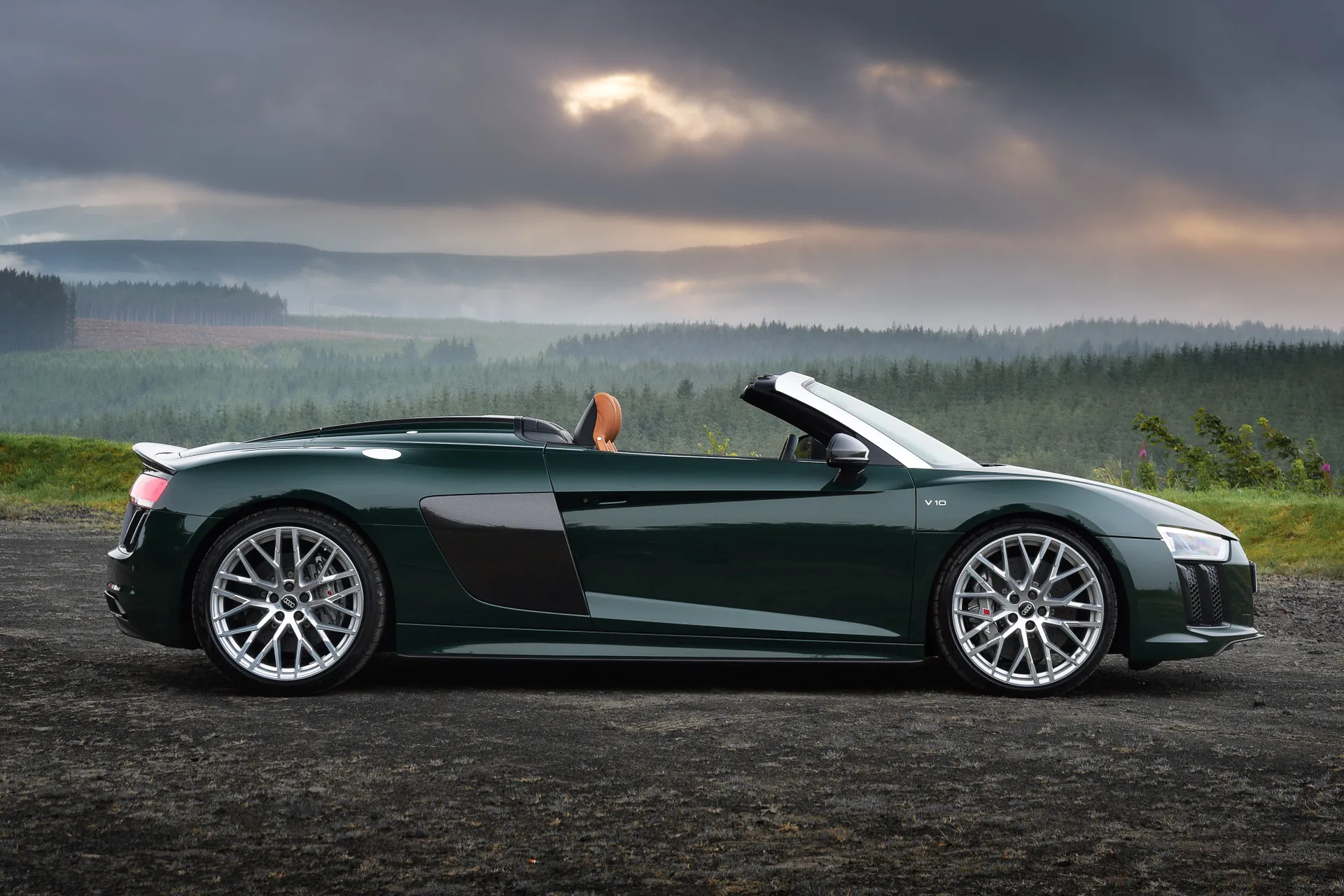
Used prices start at £110,000 for a 12 month old V10 Performance model, while three-year old models are priced between £80-90,000.
Trim levels and standard equipment
The R8 Spyder is offered in two trim levels, but the entry-level model gets a good level of equipment, with LED headlights, 19-inch cast aluminium wheels, LED tail lights, metallic paint and automatic air conditioning included as standard.
There is a surprisingly lack of features when it comes to some areas of the spec – cruise control and a reversing camera, for example, are optional extras, while safety gadgets including adaptive cruise control and autonomous emergency braking aren’t offered at all.
There are still plenty of extras though, including various colour combinations and leather finishes, meaning buyers can create an R8 to suit their style.
Navigation and parking sensors are also standard across the range, although buyers will need to seek out the range-topping V10 Plus model to get the reversing camera and fully digital instrument display.
Another reason to choose the V10 Plus is the seats. Unlike the standard model, the range-topping V10 Plus has sports bucket seats with electric height adjustment. These provide better comfort, owing to the high level of padding and support for the back and lower leg areas.
The R8 Spyder was given a comprehensive update in 2020, with the digital instrument display and reversing camera being fitted as standard to all models. The exterior was also revised, with larger grilles and air intakes.
Rear-wheel drive models were added to the R8 Spyder line-up in 2020, along with a special Carbon Black edition. The latter is perhaps the most desirable of all of the R8 Spyder derivatives, thanks to its special edition five-spoke 20-inch cast aluminum wheels and unique styling pack that includes sideblades and Audi emblem and badges in black high gloss.
Get our latest advice, news and offers
Keep me updated by email with the latest advice, news and offers from heycar.
By submitting you agree to our privacy policy
